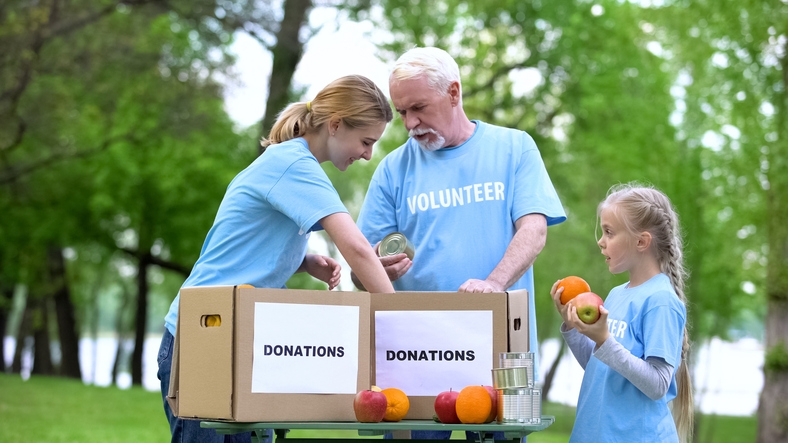How to Handle Sponsorships for Your Event (and Build Long-Term Partnerships)
Learn effective strategies for securing and managing sponsorships at your events. Enhance your planning skills and maximize your partnerships. Read more!

How to Handle Sponsorships for Your Event (and Build Long-Term Partnerships)
Introduction
Securing strong event sponsors is one of the most critical parts of charity event planning. The right partnerships not only bring in more money through monetary sponsorship and in kind sponsorships, but also provide brand recognition, media coverage, and long-term support from your local community. Whether you’re planning virtual events, hybrid events, or in-person fundraisers, knowing how to handle sponsorships for your event can be the difference between a basic fundraiser and a truly successful event.
This guide walks event planners through every step of securing sponsors, creating mutually beneficial partnerships, and ensuring sponsor events generate a measurable return on investment (event ROI).
1. Clarify the Role of Corporate Sponsorship in Your Fundraising Event Strategy
Before reaching out to potential sponsors, you need absolute clarity on why sponsorship exists in your event strategy. Too many nonprofits chase sponsors without connecting the dots between their event goals and the value exchange sponsors expect.
How to do this well:
- Start with your mission statement and event’s purpose. Ask:
- Does this fundraising event define a clear social or community impact?
- How will sponsorship dollars contribute directly to that impact?
- Tie sponsorship levels to fundraising goals. Example: If your next event aims to raise $150,000, set sponsorship tiers that cover at least 30–40% of that target. This ensures you’re not relying solely on ticket sales or peer-to-peer fundraisers.
- Map sponsorship to your audience touchpoints. Sponsors don’t just care about your event attendees — they care about the reach beyond the event (social media platforms, email lists, media coverage). Create a visibility map showing:
- Pre-event: sponsor logos on promotional materials, social media posts, and ticketing pages.
- During event: sponsor mentions on event apps, signage, stage shout-outs, and branded event materials.
- Post-event: sponsor recognition in highlight videos, recap reports, and future event promotions.
Pro tip: Use event data from past events to prove value. Example: “At last year’s gala, sponsor logos were viewed 42,000 times across social media and 3,500+ attendees engaged with sponsored activities.” This level of specificity makes your proposal feel like a business case rather than a donation request.
2. Find Established Companies and Local Businesses That Match Your Mission
Not every company is a good fit. Alignment beats reach. A smaller local business that shares your values may deliver a more authentic partnership (and renew year after year) than a larger brand with no mission overlap.
Steps to research effectively:
- Segment sponsor prospects into tiers:
- Community leaders/local businesses: Restaurants, gyms, banks, and clinics that want local visibility.
- Established companies: Regional or national brands looking for structured corporate sponsorship opportunities.
- Media sponsors: Radio stations, newspapers, and digital outlets that provide coverage in exchange for recognition.
- In-kind sponsors: Tech companies donating event apps, printers offering free event materials, or venues offering discounted rates.
- Cross-check values and audience overlap:
- Look at the sponsoring company’s CSR (Corporate Social Responsibility) reports or mission statements.
- See where their target audience aligns with your event audience.
- Avoid “brand misalignment” (e.g., a fast-food chain sponsoring a wellness fundraiser can raise eyebrows).
- Leverage past sponsors and networks:
- Ask board members, event organizers, and business partners who they already have warm connections with.
- Analyze which past sponsors renewed and why. That’s your baseline for a stronger future pipeline.
Example in practice: If your nonprofit event supports environmental sustainability, a local solar energy company or a national outdoor gear retailer is a far better fit than a generic sponsor that doesn’t tie into your cause.
Tools to track sponsor prospects:
- CRM systems like Little Green Light or Kindful (track outreach, follow-ups, renewals).
- Event website sponsorship page: showcase sponsorship opportunities and allow companies to register interest.
- Event apps: monitor which brands interact most with your digital event materials or ads — a clear sign of interest.
3. Design Sponsorship Packages That Appeal to Your Target Audience
A good proposal is a pitch deck, not a donation letter. It must show sponsors exactly what they’ll get — in visibility, access, and ROI.
Key elements of a strong proposal:
- Event details with clarity
- Specify date, location, and format (in-person, virtual, or hybrid events).
- Include expected attendance and event’s purpose.
- Audience insights backed by data
- Demographics (age, income, geography).
- Psychographics (values, lifestyle — e.g., 70% of attendees are environmentally conscious).
- Engagement metrics: past ticket sales, app usage, highly engaged audience behavior.
- Sponsorship incentives and levels
- Go beyond just logo placement. Examples:
- VIP speaking opportunities at sessions.
- Sponsored networking lounges (virtual or in-person).
- Sponsor logos integrated into event apps or gamification challenges.
- Custom photo booth with sponsor branding for high shareability on social media.
- Offer tiered event sponsorship levels (e.g., Platinum, Gold, Silver) with escalating benefits.
- Go beyond just logo placement. Examples:
- Projected ROI
- Media coverage reach (number of impressions via media sponsors).
- Digital engagement (social media reach, event website clicks, sponsorship page visits).
- On-site engagement (number of booth visits, attendee interactions).
For additional strategies on increasing attendance and maximizing ROI, see this step-by-step event marketing guide.
Best practices for pitching:
- Always include case studies from past events: “Our 2023 gala helped [Corporate Sponsor X] increase brand recognition among 2,500+ high-value donors, with 65% brand recall measured post-event.”
- Frame it as a mutually beneficial partnership: use phrases like “brand integration opportunities” or “community goodwill combined with measurable ROI”.
- Don’t be afraid to add custom sponsorship packages. A sponsoring company may not fit neatly into Platinum/Gold/Silver tiers but may want tailored visibility (e.g., exclusive sponsor of the event livestream).

4. Offer Flexible Sponsorship Levels — From Media Sponsorships to Monetary Sponsorships
Too many nonprofits rely on cookie-cutter Gold–Silver–Bronze packages that don’t reflect sponsor diversity. Instead, think strategically about how different types of sponsors engage: monetary sponsorships, in-kind sponsorships, media sponsorships, and hybrid activations.
How to structure effective sponsorship levels:
- Tiered Sponsorship Packages (Platinum → Bronze)Pro tip: Don’t name tiers only by metals. Consider naming tiers after your cause (e.g., “Champion Sponsor,” “Youth Builder,” “Community Ally”). It makes the connection between the sponsor and mission stronger.
- Platinum (highest level): Includes stage time, exclusive branded activations, lead capture rights, and top logo placement.
- Gold: Prominent recognition on event materials, social media posts, and dedicated press coverage mentions.
- Silver: Branding on digital and physical event signage, inclusion in the event app.
- Bronze: Social media mentions, sponsor logos on event website.
- Custom Sponsorship Opportunities
Instead of locking every sponsor into pre-made bundles, create à-la-carte add-ons that can align with their goals. Examples:- Sponsored Social Media Content → Let sponsors “own” a countdown post or event highlight video on your social media platforms.
- Branded Lounges/Experiences → Sponsors can design a relaxation zone, photo booth, or hydration station.
- Data-Driven Recognition in Event Apps → Feature them on the home screen of your event app, track sponsor engagement clicks, and share performance reports post-event.
- Exclusive Networking Access → Private dinners or roundtables with board members, speakers, or community leaders.
- Flexible Budget Options
- Offer low-barrier entries for local businesses (like sponsoring one giveaway item).
- Offer big-ticket impact sponsorships for established companies seeking maximum brand recognition.
Why this matters: The more flexible your event sponsorship levels, the easier it becomes for event organizers to find event sponsors across different budget ranges while increasing total sponsorship dollars raised.
5. Secure More Money Through Sponsor Incentives and Mutually Beneficial Partnerships
Sponsors don’t just want visibility — they want measurable outcomes tied to their investment. Treat them like long-term business partners, not one-time donors.
Key strategies to secure sponsors effectively:
- Translate Event Goals into Sponsor ValueThis ties their sponsorship dollars directly to results, improving buy-in.
- If your goal is increasing ticket sales, show how sponsor dollars boost your reach (ads, PR, influencer support).
- If your goal is community impact, share metrics (e.g., “Every $5,000 sponsorship supports 50 after-school program scholarships”).
- Offer High-Value Sponsor Incentives
- Media Coverage: Guarantee a mention in press releases, interviews, or event recaps.
- Branded Activations: Think beyond logos — let them host a panel, a product showcase, or a networking lounge.
- Audience Access: Give corporate sponsors tools to interact with attendees (QR codes for lead capture, post-event audience insights).
- Showcase Event ROI with Data
Use event data from past sponsors and past events:Sponsors are far more likely to renew for future events if you can prove ROI.- Social media impressions and engagement.
- On-site audience surveys showing sponsor recall.
- Click-through rates from sponsorship placements in event apps or websites.
Pro tip: Always position sponsorship as a mutually beneficial partnership. You’re not just asking for money — you’re offering brand recognition, customer access, and mission alignment.
6. Deliver on Promises: How to Give Sponsors Real Value During the Event
Getting a sponsor is only half the job — retaining them for your next event depends on how well you deliver during the current one.
Steps to ensure you deliver (and over-deliver):
- Maximize Sponsor Visibility (Digital + Physical)
- Feature sponsor logos in all event materials: tickets, signage, slides, digital programs, and your sponsorship page.
- Use event apps to push sponsor notifications or showcase their offers.
- Place sponsor logos in high-traffic areas (entrances, registration desk, stage backdrops).
- Give Real-Time Recognition
- Announce corporate sponsors during key sessions.
- Share live shout-outs on your social media platforms (tagging sponsoring companies for maximum visibility).
- Integrate sponsor logos into real-time event updates, livestream lower-thirds, or highlight reels.
- Engage Sponsors Actively
- Invite sponsors to speak or host a Q&A.
- Encourage media sponsors to cover behind-the-scenes content featuring sponsor involvement.
- Create interactive moments like sponsor-hosted giveaways or branded charging stations.
- Track and Share Performance
- Use QR codes, app data, and post-event surveys to measure sponsor engagement levels.
- Share a post-event sponsorship report with impressions, ticket sales impact, media coverage, and attendee engagement.
Why this matters: Sponsors notice when you exceed expectations. Over-delivering on promises significantly increases your chances of securing them again for your next fundraising event or expanding their investment to higher sponsorship levels.
7. Track ROI and Show Sponsors Why Their Sponsorship Dollars Were Well Spent
Corporate sponsors aren’t just donating — they’re investing in visibility, brand goodwill, and meaningful community connections. To secure repeat sponsorships, you must prove their ROI with hard data.
How to Track Sponsor ROI Effectively:
- Brand Visibility Metrics
- Track impressions of sponsor logos across event materials, event apps, social media campaigns, and live streams.
- Engagement Metrics
- Use UTM links or custom discount codes in sponsor promotions to directly attribute ticket sales or donations.
- Audience Demographics
- Share breakdowns of attendee tracking job titles, industries, and geographies — sponsors care about audience fit more than sheer volume.
- Sentiment Analysis
- Use social listening tools (Sprout Social, Brandwatch, or even Hootsuite) to track positive mentions of the sponsor’s brand during the event.
Pro Tip: Create a Sponsor Impact Dashboard (via Google Data Studio or Power BI) so sponsors can see live updates during and after the event.
8. Build Lasting Relationships: Nurturing Sponsors for Your Next Fundraising Event
One of the biggest mistakes nonprofits make is treating sponsorships as one-off deals. Long-term relationships are far more valuable than single-event partnerships.
Post-Event Best Practices:
- Send Personalized Reports
- Go beyond generic thank-yous — provide a visual ROI summary with infographics showing how their sponsorship dollars drove impact (e.g., “Your sponsorship funded 500 meals for local families”).
- Exclusive Previews for Next Fundraising Event
- Invite them to an early sponsorship round for your next fundraising event before opening it to new partners. This makes them feel valued.
- Public Recognition
- Highlight sponsors in post-event press releases, newsletters, or “impact stories” on your website. For media sponsors, repurpose event coverage into blog or video content that continues to circulate.
- Year-Round Engagement
- Don’t wait until your next event. Invite sponsors to site visits, community service days, or smaller nonprofit activities. The more emotionally invested they are in your mission, the more likely they are to renew at higher sponsorship tiers.

9. Avoid Common Sponsorship Mistakes That Cost You Credibility and Future Deals
Even seasoned event planners often fall into traps that cost them strong sponsor relationships. Avoiding these ensures smoother sponsor collaborations and stronger fundraising outcomes.
Mistakes to Watch Out For:
- Late Outreach
- Sponsors plan budgets months in advance. Approaching them 4–6 weeks before the event drastically reduces your chances. Best practice: Start 6–9 months before event day.
- Generic Sponsorship Proposals
- A one-size-fits-all deck doesn’t work. Each proposal should include custom audience alignment data showing why your attendees are the perfect fit for the sponsor’s marketing goals.
- Overpromising Deliverables
- Never guarantee media coverage or attendee numbers you can’t back up with past event data. This is one of the fastest ways to lose credibility.
- Poor Follow-Up
- Many non-profits lose sponsors because they don’t maintain communication post-event. Without proof of impact, sponsors are unlikely to renew.
- Neglecting Smaller Sponsors
- While Platinum sponsors are valuable, Bronze and in-kind sponsors can grow into larger commitments if nurtured. Focusing only on “big fish” limits long-term growth.
Pro Tip: Create a Sponsor Playbook for your nonprofit that documents outreach timelines, deliverables, ROI reporting templates, and post-event communication strategies. This makes sponsor management consistent, even if your event team changes.
Conclusion: Sponsorships as the Backbone of Successful Events
Handling sponsorships for charity events requires more than just selling sponsorships — it’s about building lasting, mutually beneficial partnerships with corporate sponsors, media sponsors, and local community leaders. When event planners research potential sponsors, craft strong event sponsorship proposals, deliver on promises, and nurture relationships, they not only raise more money but also lay the foundation for future events that exceed fundraising goals.
By following these charity event planning best practices, you’ll transform sponsorship dollars into sustainable impact for your non-profit event.
With Azavista, you can manage sponsorship packages, track event ROI, and deliver real value to your sponsors—all in one platform.
More Event Marketing and Promotion












